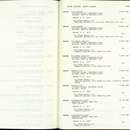Biology
provided by Arkive
Stephen's lorikeet is a generalist feeder whose diet includes nectar, pollen and fruit from a wide variety of plants, from canopy level in coconut palms to ground level shrubs, as well as the occasional insect (2) (4).
Nothing is known of this bird's reproductive biology other than specimens with developing gonads were collected in April, and a female had an enlarged ovary in May (2).
Conservation
provided by Arkive
Safeguarding Stephen's lorikeet appears to rely on ensuring the integrity of Henderson Island (5) and, in 1988, the uninhabited island was designated a World Heritage Site (4). It has been advocated that further research into the impact the Pacific rat has on the bird should be conducted and, potentially, rat eradication should be considered (4) (5). The possibility of rat eradication has been investigated and deemed feasible but is thought to be difficult because of the island's isolation (4).
Description
provided by Arkive
Stephen's lorikeet is a colourful red-and-green bird with a golden-yellow bill and eyes. Upperparts are dark green shading to golden-yellow at the tip of the wedge-shaped tail (2) (4). The cheeks and underparts are vivid red, with a dark purple patch on the belly and a broken breast band across the chest that is green at the sides and purple in the centre (2) (4).
Habitat
provided by Arkive
Found in native forest, favouring forest edge, and in coconut palms along the shoreline (4).
Range
provided by Arkive
Restricted to Henderson Island in the Pitcairn Group, a small uninhabited, raised-reef island in the south-central Pacific Ocean (4).
Status
provided by Arkive
Classified as Vulnerable (VU) on the IUCN Red List 2006 (1) and listed on Appendix II of CITES (3).
Threats
provided by Arkive
Stephen's lorikeet is considered vulnerable to extinction because it has such a restricted range, where it is at risk from the accidental introduction of alien species. Fortunately, this bird appears to have adapted well to the presence of the only introduced predator on Henderson Island to date, the Pacific rat (Rattus exulans) (4). However, the introduction of a more aggressive predator, such as black rats (Rattus rattus), could be devastating and introduced diseases such as avian malaria and pox pose another potential threat (2) (4). Additionally, the introduction of exotic plant species could have a serious impact on native vegetation and diminish essential feeding and nesting habitat for this species (4). As long as no human settlement on the island is attempted, Stephen's lorikeet should remain fairly secure, but the island's vulnerability was exposed in 1982-1983 when a millionaire sought to make it his home (2) (5).

